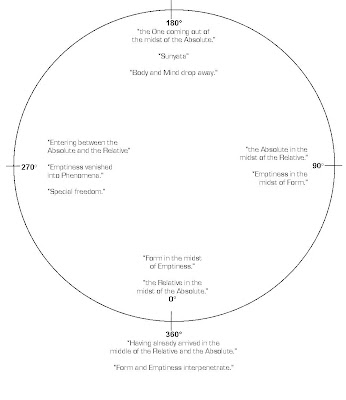Dòngshān and Sŭngsan
The five classifications of mind were set forth by Dòngshān Liángjiè [Ch: 洞山良价, Jap: Tōzan Ryōkai], (807-869) who was one of the root teachers attributed with the founding of the Cáodòng House of Chán (Soto school in Japanese Zen). His analysis utilized the relative bifurcation of opposites known in the common consciousness of his students at the time. These collection of opposites are: the absolute / the relative; the fundamental / the phenomenal; form / emptiness; one / many; etc.
Zen Master Sŭngsan Hăngwon [Ch: 崇山行願], (1927-2004) was the founder of the Kwan Um School of Zen and spent much of his life teaching Lay Students throughout the West. He developed a concise method of explaining the perception of reality based upon what he called the Compass of Zen.
Zen Master Dòngshān and Zen Master Sŭngsan were noted for creating easy mnemonics that helped their practitioners "easily" understand the teaching of Śākyamuni Buddha. The Five Levels of Zen Master Dòngshān Liángjiè and Zen Master Sŭngsan's Compass of Zen which are remarkably similar and point to the same insight.
The Five Levels are varying levels of perception and the mind formulated by Zen Master Dòngshān Liángjiè.
“Form in the midst of Emptiness.”
“the Relative in the midst of the Absolute.”
“Emptiness in the midst of Form.”
“the Absolute in the midst of the Relative.”
“the One coming out of the midst of the Absolute.”
“Śūnyatā, Body and Mind drop away.”
“Entering between the Absolute and the Relative”
“Emptiness vanished into Phenomena, Special freedom.”
“Having already arrived in the middle of the Relative and the Absolute.”
“Form and Emptiness interpenetrate.”
Zen Master Sŭngsan used the analogy of degrees on a compass and worded it a bit differently from Dòngshān, yet the fundamental explanation is the same. Explore the teachings, there is never anything new under the sun. The following is a quick comparison of the two explanations.
Sŭngsan's Small "I" @ 0° on the Compass
"attachment to name and form."
Dòngshān's “Form in the midst of Emptiness.”
“the Relative in the midst of the Absolute.”
Sŭngsan's Karma "I" @ 90° on the Compass
"attachment to thinking."
Dòngshān's “Emptiness in the midst of Form.”
“the Absolute in the midst of the Relative.”
Sŭngsan's Nothing "I" @ 180° on the Compass
"attachment to emptiness."
Dòngshān's “the One coming out of the midst of the Absolute.”
“Śūnyatā, Body and Mind drop away.”
Sŭngsan's Freedom "I" @ 270° on the Compass
"attachment to freedom."
Dòngshān's “Entering between the Absolute and the Relative”
“Emptiness vanished into Phenomena, Special freedom.”
Sŭngsan's Big "I" @ 360° on the Compass
"non-attachment thinking."
Dòngshān's “Having already arrived in the middle of the Relative and the Absolute.”
“Form and Emptiness interpenetrate.”
this blog will continue at some point with more detail.
First grapic from the original Compass of Zen Teaching by Zen Master Sungsan
Second graphic of Dongshan's Five Levels of Awareness by Paul Lynch, JDPSN
Labels: zen

2 Comments:
Thanks for this, Paul.
Barry
Thanks a lot, sir.
This is helpful. I will try to understand this.
Regards,
Post a Comment
Subscribe to Post Comments [Atom]
<< Home